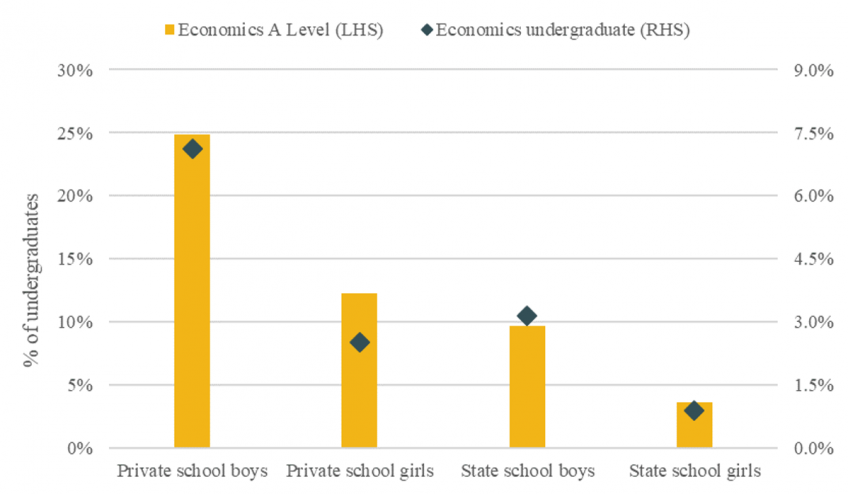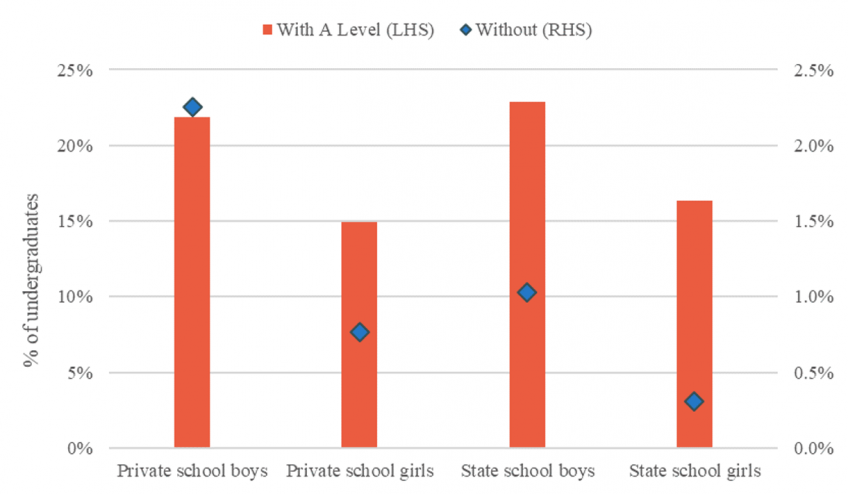Improving diversity among economists requires looking to choices at school
Despite their important role in research and analysis that influences both corporate and public policy, economists are not very representative of society. This reflects unequal representation among those who study economics: women and state school pupils are much less likely to choose to study the subject at university, and previous IFS research has shown that there are big differences between ethnic groups in their take-up of economics as well. Beyond the representativeness of the profession, the low take-up of economics by those from underrepresented groups has broader implications for inequalities in pay and social mobility in light of evidence that economics degrees offer some of the highest financial returns of all subjects in the UK.
Existing research raises the question as to what drives differential take-up of the subject across groups. Understanding this is necessary for identifying possible interventions to ensure access and improve diversity among economists in the long-term. The nature of the UK university system is such that most prospective students are required to decide on a specialism at age 17, suggesting that it is crucial to look at the choices made at school by individuals.
The effect of choices made at school
Data from the Higher Education Statistics Agency (HESA) confirm the importance of school choices. In the 2018/19 academic year, there were nearly 1.7 million UK-domiciled undergraduate students enrolled on their first degree in UK universities, with 2% of these studying economics overall. Among those studying economics, 69% held an Economics A Level, though only 7% of all undergraduates do so. But even this understates the importance of the A Level.
While more than 1 in 5 with an Economics A Level studied the subject at university, only 1 in 150 of those without an Economics A Level did so. Economics A Level is therefore hugely important as a gateway into the discipline, even though no UK university requires prospective students to have taken the qualification and there is no difference in university performance between those that have and haven’t taken it after accounting for other student characteristics. This is perhaps unsurprising given that most students likely have no other opportunity for exposure to the subject, and evidence suggests that public understanding of economics and the work of economists is oftenlimited.
The importance of “take-up” of A Level Economics for the representation of those from different backgrounds is stark. More than 7% of undergraduate boys from private schools were studying economics in 2018/19, compared with less than 1% of girls from state schools (Figure 1). This largely mirrors differences in the share of students that hold an A Level in economics across these groups, which varies from 25% for private school boys to less than 4% for state school girls.
Conditional on holding an A Level in economics and attending university, there is an important gender dimension to “conversion” to undergraduate economics (Figure 2). Specifically, conversion is higher among boys than girls. Almost a quarter (23%) of boys at UK universities who took A Level economics also study it at degree level, with very little difference between state and private school students. Although they are less likely to have studied Economics A Level if coming from a state school, those who take it are no less likely to opt for economics at undergraduate level. In contrast, conversion rates are much lower among girls: only one-in-six (16%) undergraduates with an Economics A Level study economics at university. Again, there is little difference between private and state school girls on this margin. The low share of girls in undergraduate economics is therefore not purely based on a knowledge gap about what economics is – even among those who have studied it, fewer girls than boys are attracted enough to stay.
In contrast, both boys and girls from state schools without an Economics A Level are much less likely to take up the subject at university – by around two-thirds in both cases – when compared with their private school counterparts. This only underlines the importance of the A Level as a gateway to the subject for those from state school backgrounds.
Actions to improve diversity
This evidence makes it clear that interventions to improve diversity in economics must consider the choices available, and the choices taken, while at school. Improving take-up of A Level economics is essential to reduce the gap in those going on to study for a degree in economics between state and private school students. Economics has been gaining popularity as an A Level choice: in 2012/13, 6% of UK undergraduates held the qualification, compared to 7% in 2018/19. However, this growth has largely come from boys, among whom take-up increased by 1.6 percentage points (pp), compared to a 0.4pp increase among girls. There was little narrowing in holding the A Level between state and private school students, with respective increases of 0.7pp and 0.6pp overall.
Provision and access are first-order considerations here. As of 2017, half of comprehensive schools offered economics at A Level, compared with 77% of independent schools and 83% of grammar schools. Then there is the issue of take-up conditional on availability. This is particularly important for women in economics, since girls are less likely to take economics at A Level and also less likely to continue to undergraduate even when they do take it, despite no difference in A Level access. In this case, educating students about what studying and practising economics is really like, and providing information about the different career prospects of graduates, is likely to be important. Initiatives and campaigns such as Discover Economics are a promising avenue in this respect.
Of course, other – and earlier – subject choices are also crucial. While no undergraduate economics course in the UK requires prior experience of the subject, some do require an A Level in Mathematics. Thus, access to these undergraduate economics courses – which are typically some of the most presitigious on offer – is wholly contingent on subject choices made at age 15 or 16. The underrepresentation of girls in STEM A Levels and the potential drivers of this is something addressed in IFS research.
An important point to note for all of this is that the figures presented here pertain only to students who actually go to university. Thus, given different entry rates into higher education across groups, the underrepresentation of those from state school backgrounds is understated, whereas that of girls may be slightly overstated. This serves to underline the point that the economics discipline functions within a system characterised by much broader inequalities in access, and addressing these systematic inequalities is undoubtedly the greater but more challenging prize.
Share of undergraduates who hold an Economics A Level and who are studying economics at university (2018/19)

Note: Figure shows percentage of all first degree UK domiciled students at UK universities studying economics in the 2018/19 academic year, and the percentage of all first degree UK domiciled students at UK universities in 2018/19 academic year that hold an Economics A Level. Excluded are students whose school type is “unknown or not applicable” (8.7% of the total) or whose sex is “other” (less than 0.1% of the total).
Source: HESA.
Take-up of economics among undergraduates with and without an Economics A Level (2018/19)

Note: Figure shows percentage of all first degree UK domiciled students at UK universities studying economics in the 2018/19 academic year among those holding an Economics A Level on the left axis, and among those without the A Level on the right. Excluded are students whose school type is “unknown or not applicable” (8.7% of the total) or whose sex is “other” (less than 0.1% of the total).
Source: HESA.











